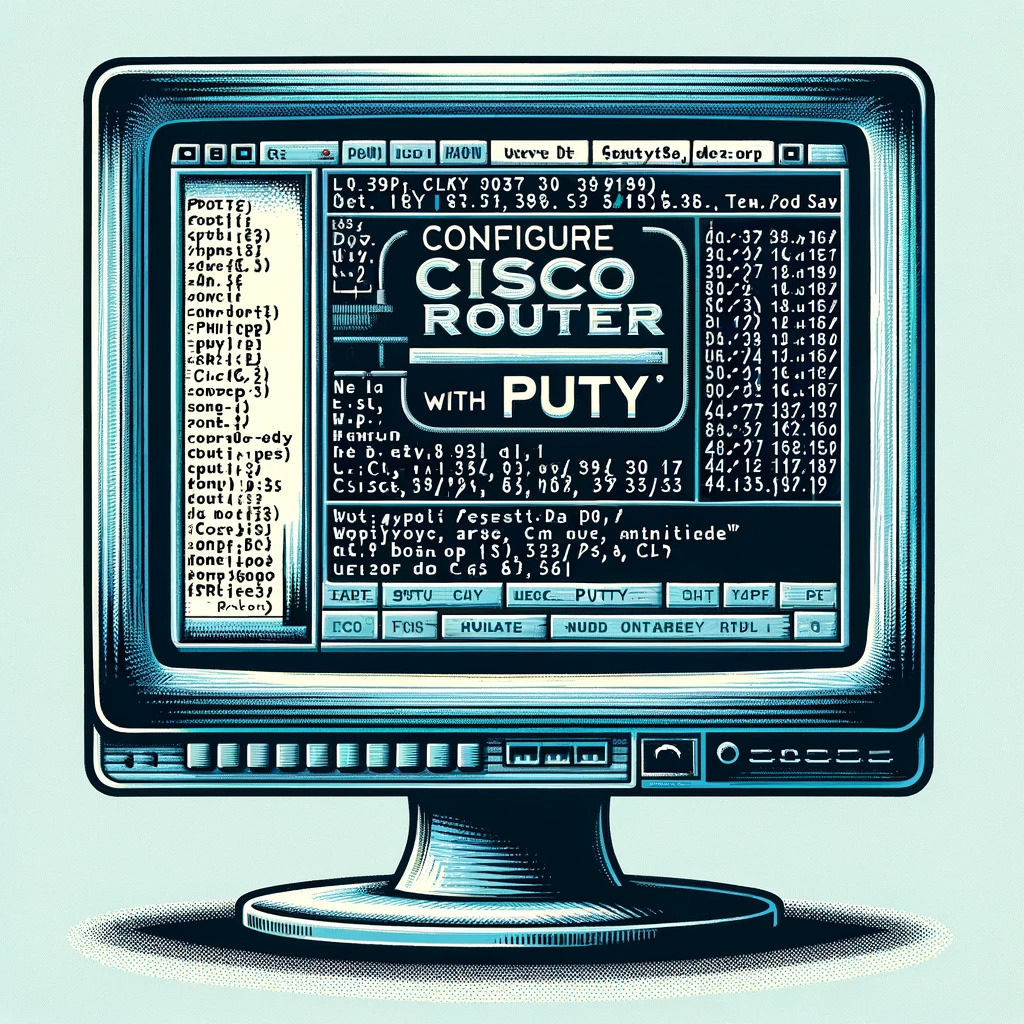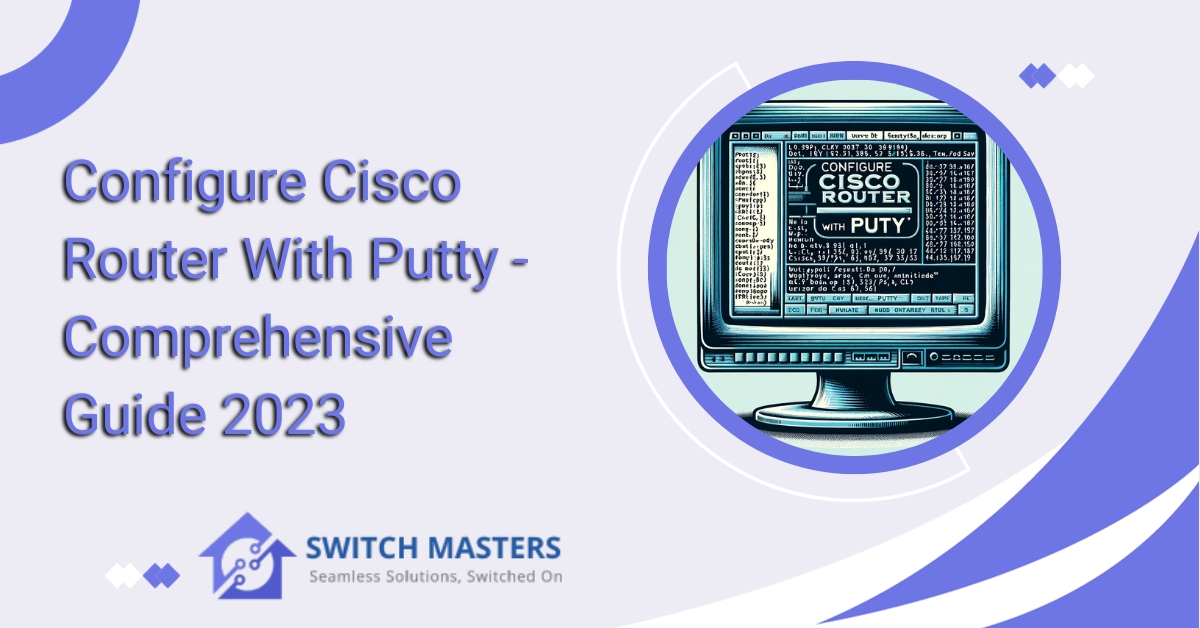Discover a streamlined approach to network management by learning how to configure Cisco router with PuTTY. Unlock the potential of your network infrastructure with PuTTY’s user-friendly interface, making the configuration process efficient and precise. Gain control over your Cisco router settings, ensuring a secure and tailored network environment.
Introduction
Using PuTTY to configure a Cisco router opens the door to an array of network customization and optimization options. Providing a user-friendly interface and a multitude of features, PuTTY emerges as an invaluable ally in the complex landscape of network administration. Here is an introduction to connecting and configuring a Cisco router using PuTTY, offering enhanced control, security, and efficiency in managing your network infrastructure.
Explore the seamless integration of these technologies, as we navigate through the steps that empower you to tailor your Cisco router settings with precision and ease. Let’s embark on this exploration of configuring a Cisco router with PuTTY, where the convergence of simplicity and sophistication transforms your network administration experience.
Table of Contents
Configure Cisco Router With Putty?
This guide provides step-by-step instructions on how to configure a Cisco router using the PuTTY terminal emulator.
Prerequisites
- A Cisco router
- A computer with network access to the router
- PuTTY installed on your computer
Step 1: Connect to the Router
- Connect your computer to the Cisco router using a console cable.
- Open PuTTY on your computer.
Step 2: Configure PuTTY
- In the PuTTY Configuration window, select `Serial`.
- Enter the appropriate COM port.
- Set the speed (baud rate) to `9600`.
- Click `Open`.
Step 3: Access Router Command Line
- Press `Enter` to access the router’s command line interface (CLI).
- If prompted, enter the router’s username and password.
Step 4: Enter Global Configuration Mode
Cisco
- Router> enable
- Router# configure terminal
- Router(config)#
Step 5: Assign IP Addresses
- Router(config)# interface gigabitEthernet 0/0
- Router(config-if)# ip address 192.168.1.1 255.255.255.0
- Router(config-if)# no shutdown
Step 6: Save Configuration
- Router(config)# exit
- Router# write memory
Remote Configuration: Managing Cisco Routers from Anywhere with Putty
In today’s interconnected world, the ability to manage network infrastructure remotely is essential. PuTTY, a versatile terminal emulator, is a tool that allows network administrators to configure Cisco routers from anywhere. This guide outlines the process of setting up and managing Cisco routers remotely using PuTTY.
Setting Up Remote Access
Before you can manage a Cisco router remotely, ensure that the router is set up for remote access. This typically involves configuring the router to accept SSH or Telnet connections.
Enabling SSH on Your Cisco Router
Access the router via console cable and enter global configuration mode:
- Router> enable
- Router# configure terminal
Set the hostname and domain-name:
- Router(config)# hostname MyRouter
- Router(config)# ip domain-name mydomain.com
Generate the encryption key:
- Router(config)# crypto key generate rsa
Specify the key length (e.g., 1024 bits):
- The name for the keys will be: MyRouter.mydomain.com
- Choose the size of the key modulus in the range of 360 to 2048 for your
- General Purpose Keys. Choosing a key modulus greater than 512 may take a few minutes.
- How many bits in the modulus [512]: 1024
Create a user with a password:
- Router(config)# username admin privilege 15 secret mysecretpassword
Enable SSH and line vty configurations:
- Router(config)# ip ssh version 2
- Router(config)# line vty 0 4
- Router(config-line)# transport input ssh
- Router(config-line)# login local
Save the configuration:
- Router(config)# exit
- Router# write memory
Using PuTTY for Remote Management
Once your router is configured for SSH, you can manage it remotely using PuTTY.
Connecting to the Router
- Launch PuTTY on your remote computer.
- Enter the router’s IP address or domain name in the Host Name (or IP address) field.
- Select SSH as the Connection type.
- Click Open to initiate the connection.
- When prompted, enter your username and password.
Common Management Tasks
View the current configuration:

- MyRouter# show running-config
Change interface settings:
- MyRouter(config)# interface GigabitEthernet0/1
- MyRouter(config-if)# ip address 192.168.1.1 255.255.255.0
- MyRouter(config-if)# no shutdown
Modify routing protocols:
- MyRouter(config)# router ospf 1
- MyRouter(config-router)# network 192.168.1.0 0.0.0.255 area 0
Implement access control lists (ACLs):
- MyRouter(config)# access-list 101 permit ip any any
Update firmware or operating systems:
- MyRouter# copy tftp: flash:
Backup and restore configurations:
- MyRouter# copy running-config tftp:
Best Practices for Cisco Router Maintenance and Updates with Putty
Maintaining and updating Cisco routers is crucial to ensure network reliability, security, and performance. PuTTY, an SSH and Telnet client, is a popular tool for performing these tasks. Below are best practices for maintaining and updating Cisco routers using PuTTY.
Regular Maintenance Tasks
Scheduled Backups
- Automate backups: Configure automated backups of your router configurations to a secure server using the kron policy-list feature.
Monitoring Performance
- Review logs: Regularly review router logs to identify anomalies or issues using the show logging command.
- Monitor traffic: Use commands like show interfaces to monitor traffic loads and identify potential bottlenecks.
Security Audits
- Check for vulnerabilities: Periodically review Cisco advisories and ensure your router configurations adhere to the latest security practices.
- Update access lists: Regularly update and review access control lists (ACLs) to ensure only authorized traffic is allowed.
Updating Cisco Routers
Firmware Updates
- Verify compatibility: Before updating, ensure that the new firmware is compatible with your router model and configuration.
- Test updates: Apply updates in a test environment before rolling them out to production routers.
Configuration Changes
- Change management: Use a change management system to track all configuration changes for auditing and rollback purposes.
- Document changes: Keep detailed records of changes, including the reason for the change and its impact on the network.
Using PuTTY for Maintenance and Updates
- SSH connections: Always use SSH for secure connections to your router. Configure PuTTY to use SSH and save sessions for quick access.
- Session logging: Enable session logging in PuTTY to keep a record of your maintenance and update sessions for future reference.
- Batch commands: Write a script with all necessary commands and use PuTTY’s copy-paste feature to execute multiple commands efficiently.
Post-Update Checks
Verify Configurations
- After updates, use show running-config to verify that configurations are applied correctly.
Test Connectivity
- Perform connectivity tests to ensure the router is functioning properly after maintenance or updates.
Review Security Settings
- Confirm that security settings are intact and that no vulnerabilities were introduced during the update process.
FAQ’s
How do I connect my console cable to my laptop using PuTTY?
When you launch PuTTY for the first time, you’ll be greeted by the Configuration window. Navigate to the Serial option on this window. Enter the COM port you wish to connect to and choose the Speed (Baud rate) you prefer. If you want to streamline your future PuTTY sessions, you can also hit Save to store the session for quicker setup the next time around. It’s like giving PuTTY a shortcut to your preferred settings!
What is a PuTTY connection?
PuTTY finds its most frequent application as a tool for File Transfer Protocol. It establishes a connection to a remote machine using SSH (Secure Shell), which is a secure protocol ensuring safe communication. Essentially, PuTTY enables a computer to securely exchange data with a distant server, creating a reliable and protected channel for sending and receiving information.
What is PuTTY console?
PuTTY, pronounced as /ˈpʌti/, stands as a freely available and open-source terminal emulator. It serves multiple functions, acting as a terminal emulator, serial console, and network file transfer application. The versatility of PuTTY is evident in its support for various network protocols such as SCP, SSH, Telnet, rlogin, and raw socket connections.
Where is my router configuration?
Fire up your web browser, key in your router’s IP address into the address bar, and hit Enter. Input your router’s username and password, and voila! You’re now logged into the admin page of your router. From this hub, you have the power to check out and tweak your network settings as needed.
What is PuTTY hostname?
In the ‘Host Name’ box, you input the server’s name or its IP address that you aim to connect to. As for the ‘Protocol’ radio buttons, they grant you the freedom to select the type of connection you prefer – whether it’s a raw connection, Telnet connection, rlogin connection, or an SSH connection. It’s all about customizing your connection experience!
Conclusion
Configuring a Cisco router with PuTTY opens up a world of possibilities for network customization and management. PuTTY’s user-friendly interface and versatile features streamline the process of connecting to a Cisco router, providing users with the tools to adjust settings efficiently. By navigating through PuTTY’s various options, users can establish a secure and reliable connection, ensuring that the Cisco router operates according to their specific requirements.
Whether fine-tuning network protocols or adjusting security measures, the synergy between PuTTY and Cisco routers empowers users to take control of their network infrastructure with ease and precision. The seamless integration of these technologies marks a significant step towards efficient network administration, fostering a smoother and more responsive digital experience.















